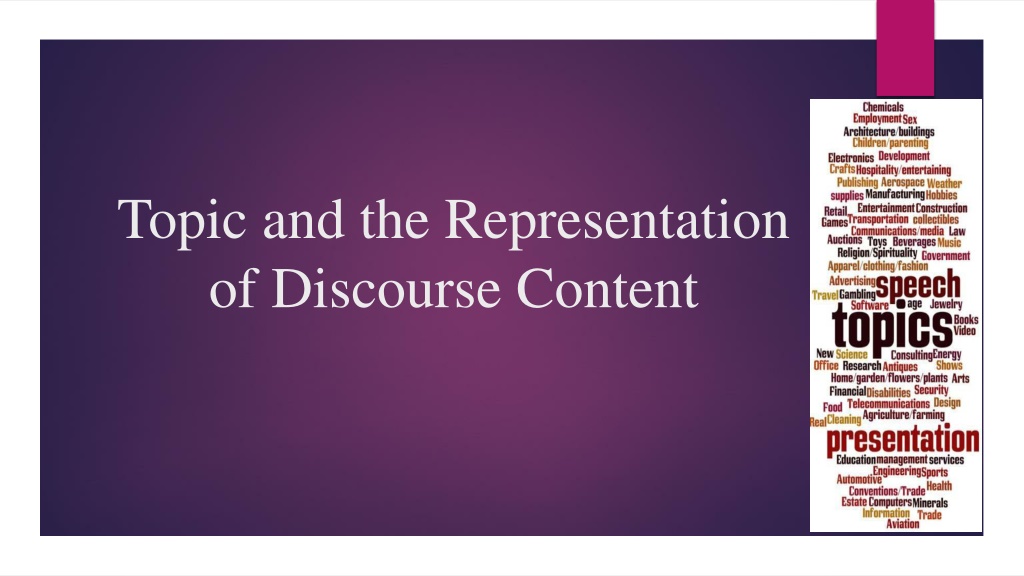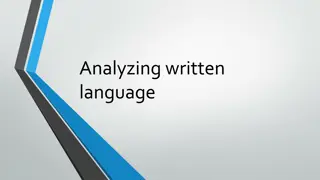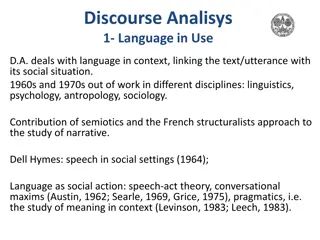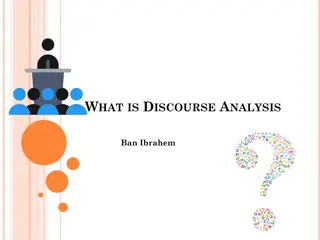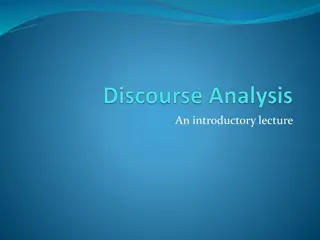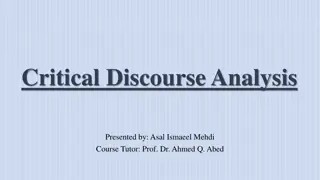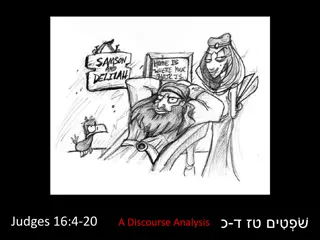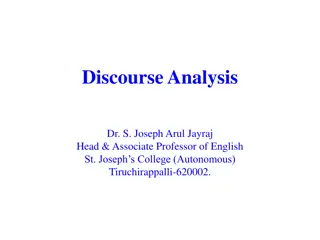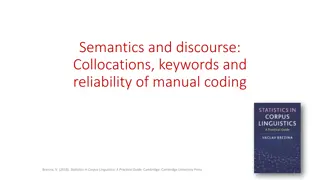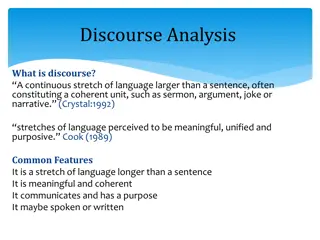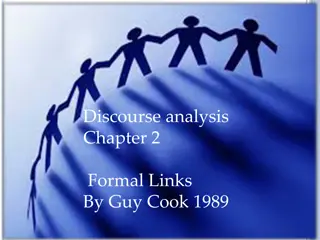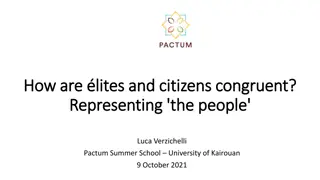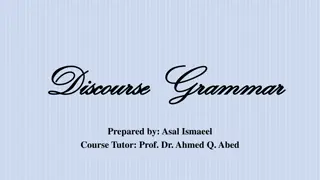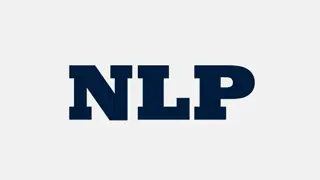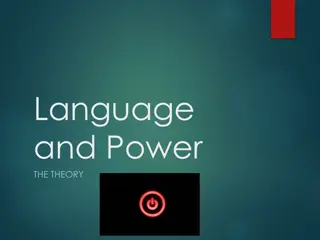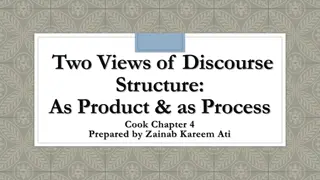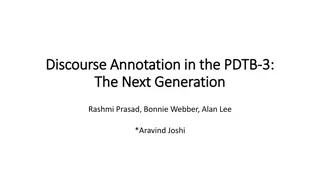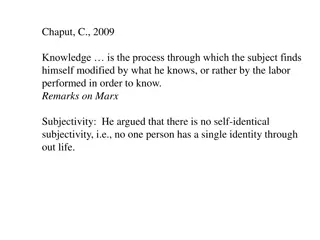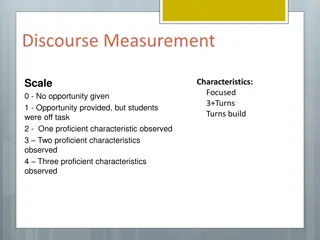Understanding Discourse Analysis and Topic Representation
Discourse analysis involves studying fragments of conversations and deciding on their boundaries. Identifying these boundaries can be explicit or implicit, using markers like formulaic expressions or intuitive notions. The notion of topic serves as a unifying principle in discourse, helping differentiate between different stretches of conversation. Topics can be categorized into sentential topics related to grammar and discourse topics. Sentential topics typically consist of the topic and the comment in a sentence. The intuitive notion of topic assists analysts in determining the end of conversational chunks.
Download Presentation

Please find below an Image/Link to download the presentation.
The content on the website is provided AS IS for your information and personal use only. It may not be sold, licensed, or shared on other websites without obtaining consent from the author. Download presentation by click this link. If you encounter any issues during the download, it is possible that the publisher has removed the file from their server.
E N D
Presentation Transcript
Topic and the Representation of Discourse Content
Discourse Analysis and the Notion Topic The data studied in discourse analysis is always a fragment of discourse and the discourse analyst always has to decide where the fragment begins and ends. There do exist ways of identifying the boundaries of stretches of discourse which set one chunk of discourse off from the rest. Formulaic expressions such as Once upon a time... And they lived happily ever after can be used explicitly to mark the boundaries of fragment.
Ways for identifying the boundaries Explicit ways: Formulaic expressions Once upon an time . . . And they lived happily ever after. Implicit ways: The analyst is forced to depend on intuitive notions about where conversation ends and another begins. one part of These markers help the analyst decide where the beginning of a coherent fragment of discourse occurs. Speaker-change: terminate a coherent fragment of conversation. it does not necessarily
Discourse Analysis and the Notion Topic There are, of course, some points where one speaker stops and another starts speaking, but every speaker-change does not necessarily terminate a particular coherent fragment of conversation. The notion of topic is clearly an intuitively satisfactory way of describing the unifying principle which makes one stretch of discourse about something and the next stretch about something else.
Intuitive notion of topic By appealing to the intuitive notion of topic the analyst can decide which point of speaker-change among the many could be treated as the end of one chunk of the conversation. The chunk of conversation in discourse then can be treated as a unit of some kind because it is on a particular topic.
Topic There are two types of topics: Sentential topic 1) Discourse topic 2)
Sentential Topic Sentential topic has to do with grammar. It is the area of grammar, syntax and semantics. Topic is the main theme of a sentence or utterance or text. When we have sentential topic, it is usually categorized into two elements: 1)Topic 2)Comment 1)Topic: Is usually the point of departure. This is something about which you talk. So what is the topic of our discussion???(It is TOPIC). 2)Comment: Is the rest of the sentence, whatever you say about the topic.
Sentential Topic Grammatically speaking, in a sentence usually topic and subject collate; they are the same. Thus, usually the first element in a sentence is the subject in declarative sentences (simple statement). Subjects might be a noun, a noun phrase, pronoun, or noun clause (nominal sentences) and the rest of the sentence is comment. Example: John ran away.
Sentential Topic Example: That new book by Thomas, I haven t read yet. Topic is like theme, and comment is like rheme . From a syntactic point of view, topic is called subject and comment is called predicate.
Sentential Topic (Chomsky vs. Halliday) In the above example (That new book by Thomas, I haven t read yet), that new book is the object , but it is at the beginning. Chomsky calls this Topicalization. It is a kind of transformation. In the deep structure this sentence is not like that. This is a result of a transformation called topicalization by which one element is brought at the beginning of a sentence to make it the topic. This is a syntactic terminology. In Halliday's terminology, it is called Thematization. They are the same things, but two different terms. The first one is syntactically oriented, but the later is pragmatically oriented.
Discourse Topic Keenan & Schiefferin It is not expressible in a simple NP. Discourse topic is a proposition about which some claim is made or elicited => it represents in any fragment of conversational discourse the topic of the whole fragment
Topic as Title For any text, there is a single correct expression which is the topic . But it should not be too difficult to imagine several different titles for a passage, each of which could equally facilitate comprehension. Therefore, in any text there is a number of different ways of expressing the topic => they represent different judgements of what is being written or talked about in a text.
Discourse Topic There is no such thing as the one correct expression of the topic for any fragment of discourse. There will be always a set of possible expressions of the topic. Tyler: the topic can only be one possible paraphrase of a sequence of utterances
Discourse Topic Topics do not belong to texts. Texts on their own have no topics. What gives a topic to a text is the speakers/hearers. So a text of itself has no topic. Topics are given to a text, they are imposed on a text. A sentence has meaning and topic through conversation in a context. Hence, it is the result of the interaction between the speaker and the hearer, or the writer and the reader. This is called discourse topic. In this sense you should talk about propositions not subjects and predicates instead.
Discourse Topic According to discourse topic, each conversation has one main topic, which is included in an utterance or in a sentence. When it comes to writing, it is called topic sentence (main idea). But again the problem is that topics can not be easily pinned down. It is not as simple as it looks. It may be wrong to say that one conversation has only one main topic. You cannot easily define what the main topic of a conversation is. So, instead you should talk about Topic Framework.
Discourse Topic Topic Framework: Example: A stitch in time saves nine. What does that mean? Interviewer: Oh! That s because all women have a little bit of magic to them- I found that out- and it s called- it s sort of good magic- and nine is sort of a magic number . Speaker: What he is trying to say is not clear. He talked about different things but not the main topic.
Discourse Topic: Topic Framework The analyst can determine what aspect of the context are explicitly reflected in the text as the formal record of the utterance. Activated features of context: aspects which are directly reflected in the text which need to be called upon to interpret the text. They constitute the contextual framework within which the topic is constituted.
Topic Framework Any consideration of topic involves asking why the speaker said what he said in a particular discourse situation.
Topic Framework Certain elements which constrain the topic can be determined before the discourse begins; they are part of the context of a speech event. In relation to contextual features to a particular speech event, however, we are particularly interested in only those activated features of context pertaining to the fragment of discourse being studied.
Topic Framework The topic framework consists of elements derivable from the physical context and from the discourse domain of any discourse fragment. These elements are a means of making explicit some of the assumptions a speaker can make about his hearer s knowledge we are talking about the total knowledge which the speaker believes he shares with his/her hearer.
Topic Framework A text, a conversation, a piece of discourse is a mixture of different propositions and different ideas. Conversation is negotiation, it s formed and created by people. As you speak, conversation develops. There is not a fixed topic in a conversation. You might start from something, then you end up with a very different topic. Conversation between two people or a text, actually constitutes a framework of topic which is called topic framework. A framework is based on the context. We have activated features in a context. In order to form this framework you need shared background knowledge.
Presupposition What is a presupposition? Expectations. Discourse works based on expectations. When I say something, I expect you to understand what I say, and when you say something you expect me to understand what you say, unless we tell lies. A presupposition is an assumption that you have in a conversation or in a text, usually some shared knowledge. This is the basis for your conversation, or the basis for a text.
Presupposition pools Venneman proposes: for a discourse, there is a presupposition pool which contains information constituted from general knowledge, from the situated context of the discourse, and from the completed part of the discourse itself. Within the presupposition pool for any discourse, there is a set of discourse subjects and each discourse is, in a sense, about its discourse subjects. For example, suppose I step in, then I say guess what happened to David. So the presupposition is that you may know David, thus the conversation will be meaningful because we all know David.
Presuppositionpools The number of the discourse subjects in a presupposition pool shared by participants in a discourse, particularly participants who know each other well, is potentially large. Selecting the discourse subjects must have to do with their relevance to the particular discourse fragment under consideration. This relevance must be those to which reference is made in the text of the discourse.
Sentential topic & the presupposition pool Presupposition pool shared by participants restricts the analyst s investigation to describe the relationship between pairs of sentences. When two people know each other, the pool is big. Because there is too much shared knowledge. (example: you and your husband/ friend), but the pool between you and a taxi driver is very small. Presupposition pool includes discourse subjects and these are subjects which are shared.
Speaking topically and speaking on the topic When you are speaking topically, you might not speak on the topic (and its most of the times the case that happens). Most conversations have lots of topics. They have a topic framework. When you speak for an hour, you speak about different subjects. This is not being on the topic, but you are topically speaking. But when you are speaking on the topic, you are also speaking topically. By nature, conversation requires speaking topically not on the topic.
Relevance and speaking topically Topic framework represents the area of overlap in the knowledge which has been activated and is shared by the participants at a particular point in a discourse. Once these have been identified, the analyst has some basis for making judgements of the relevance with regard to conversational contributions.
Conclusion: We have tried to list the connections existing across contributions in this discourse fragment to emphasize the ways in which speakers make what they re talking about fit into the framework which represents what we (as discourse participants) are talking about in conversational discourse. For the analyst, these connections can signal the coherence relations which make each contribution relevant to the discourse as a whole.
